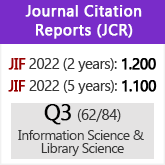An analysis of the output of the University of Navarra in terms of publications made in Social Science and Humanities journals, employing the Web of Science and a number of Spanish ranking systems
DOI:
https://doi.org/10.3989/redc.2009.1.673Keywords:
Bibliometric Indicators, Impact Factor, Social Sciences, Humanities, Scientific Journals, Spain, Web of Science, Journal Citation Reports, / IN-RECS, IN-RECJ, RESHAbstract
This paper reports a bibliometric analysis of the output of the Faculties of Social Sciences and Humanities of the University of Navarra, as recorded by publications in scholarly journals over the period 1999-2005. Information for the analysis was gathered from Journal Citation Reports (JCR) and from the Spanish Índice de Impacto de las Revistas Españolas de Ciencias Sociales (IN-RECS), Índice de Impacto de las Revistas Españolas de Ciencias Jurídicas (IN-REJS) and Revistas Españolas de Ciencias Sociales y Humanidades (RESH). The aim of this work was to determine the adequacy of these ranking systems as bibliometric tools for describing the output in Spanish journals of a university. The results show the University of Navarra published 7281 documents during the studied period, 1908 (26 %) of which were articles in journals. Just over 39 % of the latter were published in Spanish scientific journals, and 12 % in Web of Science journals. The coverage of the ranking systems varies per faculty: the IN-RECJ best covered articles published by the Law faculty; IN-RECS best represented production from Communication and Economics faculties; and RESH best covered production from Humanities faculties. Some 43 % of the studied articles recorded by IN-RECS were published in the first quartile of journals covered by the index; this figure was 42 % with respect to RESH, and 12 % with respect to JCR. Spanish national ranking systems are therefore useful as a complement to bibliometric information provided via the Web of Science and JCR.
Downloads
References
Alcaín-Partearroyo, M. D., Román-Román, A. y Giménez-Toledo, E. (2008): Categorización de las revistas españolas de Ciencias Sociales y Humanas en RESH. Revista Española de Documentación Científica, vol. 31 (1), 85-95.
ANECA (2008): Programa Academia. Principios y orientaciones para la aplicación de criterios de evaluación. http://www.aneca.es/active/docs/academia_principios_y_orientaciones_080114.pdf. [Consulta: 27/05/2008.]
Camí, J. (1997): Impactolatría: diagnóstico y tratamiento. Medicina Clínica 109, 515-524.
Delgado López-Cozar, E., Jiménez-Contreras, E. y Ruiz Pérez (2007): La edición de revistas científicas: directrices, criterios y modelos de evaluación. Madrid: Fundación Española para la Ciencia y la Tecnología.
Fernández Esquinas, M., Pérez Yruela, M. y Merchán Hernández; C. (2006): El sistema de incentivos y recompensas en la ciencia pública española. En: Sebastián, J. y Muñoz, E. (editores). Radiografía de la investigación pública en España. Madrid: Biblioteca Nueva.
Giménez-Toledo, E., Román-Román, A. y Alcaín-Partearroyo, M. D. (2007): From experimentation to coordination in the evaluation of Spanish scientifi c journals in the Humanities and Social Sciences. Research Evaluation, vol. 16 (2), 137-148. doi:10.3152/095820207X220409
Glänzel, W. y Schoepflin, U. (1999): A bibliometric study of reference literature in the sciences and social sciences. Information Processing and Management, 35, 31-44. doi:10.1016/S0306-4573(98)00028-4
Glänzel, W. y Moed, H. F. (2002): Journal impact measures in bibliometric research. Scientometrics, vol. 53 (2), 171-193.
Hicks, D. (1999): The diffi culty of achieving full coverage of international social science literature and the bibliometric consequences. Scientometrics, vol. 44 (2), 193-295.
Lindhom-Romantschuk, Y., y Warner, J. (2002): The role of monographs in scholarly communication: an empirical study of philosophy, sociology and economics. Journal of Documentation, vol. 52 (4), 389-404. doi:10.1108/eb026972
Ministerio de Educación y Ciencia (2007): Resolución de 6 de noviembre de 2007, de la Presidencia de la Comisión Nacional Evaluadora de la Actividad Investigadora, por la que se establecen los criterios específicos en cada uno de los campos de evaluación.
Moed, H. F. (2005): Citation Analysis in Research Evaluation. Dordrecht (The Netherlands); Springer.
Thomson Reuters (2008): Thomson begins expansion of the Web of Science. http://scientific.thomsom.com/press/2008/8445762. [Consulta: 12/05/2008.]
Torres-Salinas, D. (2007): Diseño de un sistema de información y evaluación científica. Análisis ciencimétrico de la actividad investigadora de la Universidad de Navarra en el área de ciencias de la salud (1999-2005). Granada: Universidad de Granada.
Van Leeuwen, T. (2006): The application of bibliometric analyses in the evaluation of social science research. Who benefits from it, and why it is still feasible. Scientometrics, vol. 66 (1), 133-154.
Downloads
Published
How to Cite
Issue
Section
License
Copyright (c) 2009 Consejo Superior de Investigaciones Científicas (CSIC)

This work is licensed under a Creative Commons Attribution 4.0 International License.
© CSIC. Manuscripts published in both the printed and online versions of this Journal are the property of Consejo Superior de Investigaciones Científicas, and quoting this source is a requirement for any partial or full reproduction.All contents of this electronic edition, except where otherwise noted, are distributed under a “Creative Commons Attribution 4.0 International” (CC BY 4.0) License. You may read here the basic information and the legal text of the license. The indication of the CC BY 4.0 License must be expressly stated in this way when necessary.
Self-archiving in repositories, personal webpages or similar, of any version other than the published by the Editor, is not allowed.

















